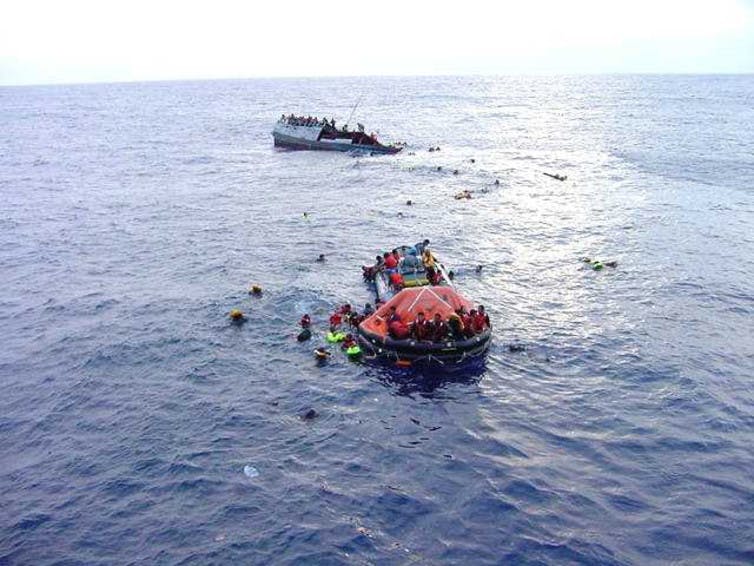The Conversation is running a series of explainers on key moments in Australian political history, looking at what happened, its impact then, and its relevance to politics today.
Some time before August 23 2001, a small Indonesian fishing boat, the KM Palapa 1, left Indonesia en route to Christmas Island with 438 asylum seekers aboard.
Like many before them, the asylum seekers hoped to reach Australia and apply for permanent protection visas. The Palapa’s engines failed in international waters between Indonesia and Australia, and it lay stranded for many days.
On August 26, the MV Tampa, a Norwegian cargo ship en route from Fremantle to Singapore, answered a call from the Australian Coast Guard and rescued the crew and passengers of the Palapa. Makeshift accommodation and bathrooms were organised on the open deck. Pregnant women were among the passengers.
A delegation of five asylum seekers was taken to see the Tampa’s captain, Arne Rhinnan. They pleaded to be taken to Christmas Island (four hours away) and threatened to jump ship if they were returned to Indonesia (11 hours away). Rhinnan told the coast guard he planned to take the rescuees to Christmas Island, which was duly noted.
However, some hours later, Neville Nixon of the Department of Immigration contacted Rhinnan to inform him that the Tampa was not to enter Australian waters – and if it did so, Rhinnan risked imprisonment and fines of up to A$110,000.
What was its impact?
It was the prime minister, John Howard, who decided to prevent the Tampa entering Australia. The decision heralded the beginning of a new, executive-led change in policy, which has been the underlying basis of the approach to asylum seekers attempting to reach Australia by boat ever since.
When the 438 asylum seekers left Indonesia on the Palapa, Australia’s policy was to rescue asylum seekers at sea and detain them in Australia while their claims for protection were processed. If their claims were successful, they would be released into the community on permanent protection visas. If they weren’t, they would be returned to their country of origin.
On October 8, six weeks after the Tampa was told it could not enter Australian waters, the Palapa survivors were forcibly removed from the HMAS Manoora onto Nauru. In the intervening period, the Australian government had introduced a policy of boat turnbacks.
The ability to construct and implement this policy less than three months out from an election was an extraordinary achievement of the Howard government, particularly given it involved complex negotiations with a foreign country (Nauru).
Also in this six-week period, ten more boats (now labelled Suspected Illegal Entry Vessels, or SIEVs) attempted to reach Christmas Island. It was a period of high drama. The Australian Navy was under orders to forcibly return boats to Indonesia under Operation Relex.
Several boats sank under navy observation. Despite the best efforts of navy personnel to rescue asylum seekers flailing in the open sea, many people drowned. In the case of SIEV-4, cabinet ministers seized on a navy communication feed that children were being thrown overboard. They immediately made the allegation public; Howard and his immigration minister declared these were not the type of people Australia wanted.
The government maintained its reliance on unverified naval intelligence right up to the federal election on November 10, without providing the navy with an opportunity to correct the record. This politicisation of navy information was the subject of a Senate inquiry in the next parliament.
Boats ceased arriving altogether after SIEV-10 sank on October 19, killing more than 350 of its 400 passengers.
The exact circumstances of the sinking of SIEV-10 remain uncertain. There can be little doubt, however, that its sinking had a significant deterrent effect on asylum seekers in Indonesia considering the journey to Christmas Island by boat.

What are its contemporary implications?
At the time of the Tampa incident, the government’s new policy of boat turnbacks seemed extreme.
However, the government ran a highly successful campaign claiming that the policy was necessary to control Australia’s borders and keep the nation safe, particularly in the aftermath of the September 11 attacks.
The government kept strict control of information. It withheld information about navy operations involving asylum seekers at sea and restricted the access of journalists to Nauru and Christmas Island. It also downplayed the effect of offshore detention on the mental and physical health of asylum seekers, and cast rescuees as undeserving of Australia’s protection – and potentially a risk to security.
The Rudd Labor government ended the Howard government’s asylum-seeker policy in 2007. Offshore detention centres were closed; boat turnbacks ceased. But, from 2010 to 2013, boats began arriving in unprecedented numbers, and Tony Abbott and the Coalition were elected on a platform that included “stopping the boats”.
The Abbott government introduced a new policy mirroring the post-Tampa policy – which included an added sting introduced by the Rudd government prior to the 2013 election that no asylum seeker arriving by boat and processed in an offshore detention centre would ever be resettled in Australia.
This present-day asylum-seeker policy has bipartisan support. It is a direct legacy of the Howard government’s decision to refuse entry to the Tampa in August 2001.

